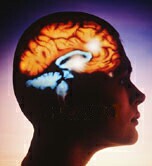
THURSDAY, Jan. 16, 2014 (HealthDay News) — Bats and other animals use ultrasound to their advantage. Now a new study of humans suggests ultrasound can alter brain activity to boost people’s sensory perception.
First, researchers placed an electrode on the wrist of volunteers to stimulate the nerve that runs down the arm and into the hand. Before stimulating the radial nerve, they delivered ultrasound to the head — to an area of the cerebral cortex that processes sensory information received from the hand. The participants’ brain responses were recorded using electroencephalography (EEG).
The ultrasound decreased the EEG signal and weakened the brain waves responsible for processing sensory input from the hands, according to the study published online Jan. 12 in the journal Nature Neuroscience.
The Virginia Tech researchers then conducted two common neurological tests. One measures a person’s ability to distinguish whether two pins placed close together and touching the skin are actually two distinct contact points. The other test measures sensitivity to the frequency of a series of air puffs.
The scientists were surprised to discover that when they received ultrasound, the participants showed significant improvements in their ability to distinguish pins at closer distances and to identify small differences in the frequency of successive air puffs.
The ultrasound may have changed the balance of inhibition and excitation between neighboring neurons within the cerebral cortex, resulting in a boost in sensory perception, explained study leader William Tyler, an assistant professor at Virginia Tech’s Carilion Research Institute.
Next, to find out how well they could pinpoint the effect, the researchers moved the ultrasound beam one centimeter in either direction from the original site of brain stimulation. They found that the enhanced sensory perception no longer occurred.
“That means we can use ultrasound to target an area of the brain as small as the size of an M&M,” Tyler said. The finding, he said, represents a new, noninvasive method of modifying human brain activity “with a better spatial resolution than anything currently available.”
More information
BrainFacts.org has more about senses and perception.
Copyright © 2025 HealthDay. All rights reserved.

